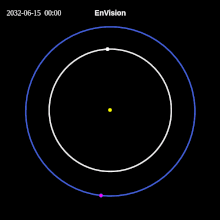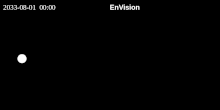 | |
| Mission type | Venus orbiter |
|---|---|
| Operator | European Space Agency |
| Website | envisionvenus.eu |
| Mission duration | Planned: 4.5 years |
| Spacecraft properties | |
| Launch mass | 2,607 kg (5,747 lb) |
| Dry mass | 1,277 kg (2,815 lb) |
| Payload mass | 255 kg (562 lb) |
| Power | 2.35 kilowatts |
| Start of mission | |
| Launch date | December 2031 (planned) |
| Rocket | Ariane 64 |
| Launch site | Kourou ELA-4 |
| Contractor | Arianespace |
| Venus orbiter | |
| Orbital insertion | 2034 |
| Orbital parameters | |
| Pericytherion altitude | 220 km |
| Apocytherion altitude | 470 km |
| Transponders | |
| Band | X-band, Ka-band |
| Cosmic Vision← ARIEL | |
EnVision is an orbital mission to Venus being developed by the European Space Agency (ESA) that is planned to perform high-resolution radar mapping and atmospheric studies. EnVision is designed to help scientists understand the relationships between its geological activity and the atmosphere, and it would investigate why Venus and Earth took such different evolutionary paths. The probe was selected as the fifth medium mission (M5) of ESA's Cosmic Vision programme in June 2021, with launch planned for December 2031. The mission will be conducted in collaboration with NASA, with the potential sharing of responsibilities currently under assessment.

EnVision · Earth · Venus · Sun

Science goals
EnVision will deliver new insights into geological history through complementary imagery, polarimetry, radiometry and spectroscopy of the surface coupled with subsurface sounding and gravity mapping; it will search for thermal, morphological, and gaseous signs of volcanic and other geological activity; and it will trace the fate of key volatile species from their sources and sinks at the surface through the clouds up to the mesosphere. Core science measurements include: high-resolution mapping of specific targets, surface change, geomorphology, topography, subsurface, thermal emission, SO
2, H
2O, D/H ratio, gravity, spin rate, and spin axis. The specific mission's goals are:
- Determine the level and nature of current activity
- Determine the sequence of geological events that generated its range of surface features
- Assess whether Venus once had oceans or was hospitable for life
- Understand the organising geodynamic framework that controls the release of internal heat over the history of the planet
A new fleet of Venus missions has been selected, and new mission concepts will continue to be considered for future selections. Missions under development include ESA's EnVision M5 orbiter mission, NASA-JPL's VERITAS orbiter mission, NASA-GSFC's DAVINCI entry probe/flyby mission. The data acquired with the VERITAS, DAVINCI, and EnVision from the end of this decade will fundamentally improve our understanding of the planet's long term history, current activity and evolutionary path.
The scientists who submitted the EnVision proposal in response to the call for proposals for the M5 mission of ESA's Cosmic Vision program are Richard Ghail of Royal Holloway, University of London, Colin Wilson, Department of Physics, University of Oxford, UK and Thomas Widemann, LESIA, Observatoire de Paris and Université de Versailles-Saint-Quentin (France).
Instruments
EnVision is an ESA mission in collaboration with NASA, and contributions from individual ESA member states for the provision of payload elements. NASA is contributing the VenSAR instrument and supplies DSN support. The other payload instruments are contributed by ESA member states, with ASI, DLR, BelSPO, and CNES leading the procurement of SRS, VenSpec-M, VenSpec-H and VenSpec-U instruments respectively.
- Venus Synthetic Aperture Radar (VenSAR), which will operate at 3.2 GHz in the S-band (9.4 cm wavelength). VenSAR will provide several imaging and ranging techniques from a polar orbit: (1) regional and targeted surface mapping, (2) global topography and altimetry, (3) stereo imaging, (4) surface radiometry and scatterometry, (5) surface polarimetry, (6) repeat pass interferometry opportunities. The Jet Propulsion Laboratory's S-band synthetic-aperture radar (VenSAR) selected by NASA is currently undergoing scientific, technical and mission assessment. A SAR is a versatile remote sensing technology that has unique capabilities for determining geophysical information often not available by other remote sensing methods. VenSAR will characterise structural, and geomorphic evidence of multi-scale processes that shaped the geological history of Venus, as well as characterise current volcanic, tectonic, and sedimentary activity. The principal investigator of the Venus Synthetic Aperture Radar is Scott Hensley, Jet Propulsion Laboratory NASA/California Institute of Technology.
- Venus Subsurface Radar Sounder (SRS), which will be a fixed dipole antenna operating in the range 9–30 MHz. SRS will search for subsurface material boundaries in various geological terrains that include impact craters and their infilling, buried craters, tesserae and their edges, plains, lava flows and their edges, and tectonic features in order to provide stratigraphic relationships at various depth ranges and horizontal scales. The principal investigator of the Subsurface Radar Sounder is Lorenzo Bruzzone, Università di Trento, Italy.
- Venus Spectroscopy Suite (VenSpec), which will consist of three channels: VenSpec-M, VenSpec-H and VenSpec-U. VenSpec-M will provide compositional data on rock types, VenSpec-H will perform extremely high resolution atmospheric measurements, and VenSpec-U will monitor sulphured minor species (mainly SO and SO2), as well as the mysterious UV absorber in the Venusian upper clouds. This suite will search for temporal variations in surface temperatures and tropospheric concentrations of volcanic gases, indicative of volcanic eruptions. The principal investigator of the Venus Spectroscopy suite and PI of VenSpec-M is Jörn Helbert, DLR Institute of Planetary Research, Berlin, Germany. The PI of VenSpec-H is Ann Carine Vandaele, Royal Belgian Institute for Space Aeronomy (BIRA/IASB), Belgium. The PI of VenSpec-U is Emmanuel Marcq, LATMOS, IPSL, France.
- Radio Science Experiment Any orbiting spacecraft is sensitive to the local gravity field, plus the gravity field of the Sun and, to a minor extent, other planets. These gravitational perturbations generate spacecraft orbital velocity perturbations, from which the gravity field of a planet can be determined. EnVision's low-eccentricity, near-polar and relatively low altitude orbit offers the opportunity to obtain a high-resolution gravity field at each longitude and latitude of the Venusian globe.
- The analysis of the gravity field together with the topography gives insights on the lithospheric and crustal structure, allowing to better understand Venus's geological evolution. In the absence of seismic data, the measurements of the tidal deformation and proper motion of the planet provide the way to probe its deep internal structure (size and state of the core). The tidal deformation can be measured in the EnVision orbital velocity perturbations through the gravitational potential variations it generates (k2 tidal Love number).
- The co-Principal Investigators of EnVision Radio Science and Gravity experiment are Caroline Dumoulin, LPG, Université de Nantes, France, and Pascal Rosenblatt, LPG, Université de Nantes, France.
See also
- Observations and explorations of Venus
- List of missions to Venus
- Akatsuki, a Japanese Venus orbiter
- DAVINCI, a NASA orbiter and atmospheric probe
- Magellan, a NASA Venus orbiter
- Venus Express, an ESA Venus orbiter
- VERITAS, a NASA Venus orbiter
- Venus Orbiter Mission, an ISRO Venus Orbiter.
- Mapping of Venus
- Volcanism on Venus
References
- ^ Foust, Jeff (27 November 2024). "VERITAS Venus mission seeks to avoid further delays". SpaceNews. Retrieved 28 November 2024.
EnVision was still planning a launch in December 2031. ESA recently changed the launch vehicle for the mission from an Ariane 62 to an Ariane 64.
- ^ Jonathan Amos (10 June 2021). "Europe will join the space party at Planet Venus". BBC News. Retrieved 11 June 2021.
- ^ R. C. Ghail; C. F. Wilson; T. Widemann; L. Bruzzone; C. Dumoulin; et al. (27 March 2017). "EnVision: Understanding Why Our Most Earth-like Neighbor is so Different". arXiv:1703.09010 .
- "ESA selects three new mission concepts for study". www.esa.int. ESA. 7 May 2018. Retrieved 10 June 2021.
- ^ T. Widemann; S. E. Smrekar; J. B. Garvin; A. G. Straume-Lindner; A. C. Ocampo l; et al. (3 October 2023). "Venus Evolution Through Time: Key Science Questions, Selected Mission Concepts and Future Investigations". Space Science Reviews. 219 (7): 56. Bibcode:2023SSRv..219...56W. doi:10.1007/s11214-023-00992-w. hdl:20.500.11850/637406. ISSN 1572-9672.
- ^ EnVision M5 Venus Orbiter Proposal: Opportunities and Challenges R. C. Ghail, C. F. Wilson and T. Widemann. 47th Lunar and Planetary Science Conference (2016)
External links
- Official site
- ESA EnVision Assessment Study Report, publication date: 18 February 2021
- EnVision deployment video, produced by VR2Planets
| Spacecraft missions to Venus | |||||||||||||
|---|---|---|---|---|---|---|---|---|---|---|---|---|---|
| Active missions |
|    | |||||||||||
| Past missions |
| ||||||||||||
| Planned missions |
| ||||||||||||
| Proposed missions |
| ||||||||||||
| Cancelled or not developed | |||||||||||||
| Program overviews | |||||||||||||
| Related | |||||||||||||
| |||||||||||||
| European Space Agency | |||||||||||||||||||||||
|---|---|---|---|---|---|---|---|---|---|---|---|---|---|---|---|---|---|---|---|---|---|---|---|
| |||||||||||||||||||||||
| |||||||||||||||||||||||
| Future missions in italics | |||||||||||||||||||||||